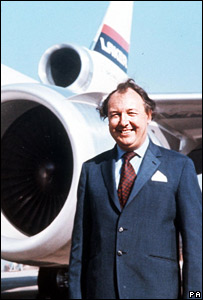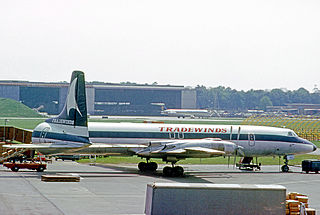 | |||||||
| |||||||
| Founded | 1968 | ||||||
|---|---|---|---|---|---|---|---|
| Ceased operations | 1974 | ||||||
| Destinations | Europe North America Asia | ||||||
Donaldson International Airlines was a British charter airline from 1968 to 1974.
 | |||||||
| |||||||
| Founded | 1968 | ||||||
|---|---|---|---|---|---|---|---|
| Ceased operations | 1974 | ||||||
| Destinations | Europe North America Asia | ||||||
Donaldson International Airlines was a British charter airline from 1968 to 1974.


Donaldson International Airways (a trading name of Donaldson Line (Air Services) Limited) was formed in 1968 to provide inclusive tour and charter flights for Mercury Air Holidays of Glasgow. The airline took delivery of two four-engined Bristol Britannia turboprop aircraft and commenced flights from its bases at London Gatwick Airport and Glasgow Airport.
As business expanded the airline acquired another two Britannia aircraft. These aircraft were also operated on charter flights from other major UK Airports including Manchester.
Donaldson Airways started charter flights across the North Atlantic with the delivery of two Boeing 707 aircraft in 1971. Another two 707s were obtained in 1972, and the Britannia aircraft were sold.
Three of the 707s were fitted with a cargo door to enable the airline to operate both passenger and freight charters. One Boeing 707 was used in an all-cargo configuration between 1973 and 1974. Donaldson took part in the evacuation of Ugandan refugees during the 1972 expulsion of Asians from Uganda in 1972, flying a Boeing 707 to London Gatwick Airport as well as to London Stansted Airport.
In May 1974 the airline operated services for Iraqi Airways, but all flying ceased on 8 August 1974 and the Boeing 707s were repossessed by Pan American Airways.[ citation needed ]
First Choice Airways Limited was a British charter airline of European tour operator TUI Travel PLC, based in Crawley, England until its merger with Thomsonfly to form Thomson Airways in 2008. It flew to more than 60 destinations worldwide from 14 UK and Irish airports. 70% of the airline's services were operated for its parent company, rising to 85% in the summer season, with the remainder on behalf of some 120 other tour operators. It also operated scheduled year-round leisure routes to Cyprus and the resorts of Spain and Portugal.

Sir Frederick Alfred Laker was an English airline entrepreneur, best known for founding Laker Airways in 1966, which went bankrupt in 1982. Known as Freddie Laker, he was one of the first airline owners to adopt the "low cost / no-frills" airline business model that has since proven to be successful worldwide when employed by companies such as Ryanair, Southwest Airlines, easyJet, Norwegian Air, and AirAsia.
Monarch Airlines, also known as Monarch, was a British charter and scheduled airline founded by Bill Hodgson and Don Peacock and financed by the Swiss Sergio Mantegazza family. The company later became a low-cost airline in 2004 before abandoning charter flying completely. The airline's headquarters were based at Luton, and it had operating bases at Birmingham, Leeds/Bradford, Gatwick and Manchester.

The Bristol Type 175 Britannia is a retired British medium-to-long-range airliner built by the Bristol Aeroplane Company in 1952 to fly across the Commonwealth. During development two prototypes were lost and the turboprop engines proved susceptible to inlet icing, which delayed entry into service while solutions were sought.
British Caledonian (BCal) was a British private independent airline which operated out of London Gatwick Airport in south-east England during the 1970s and 1980s. It was created as an alternative to the British government-controlled corporation airlines and was described as the "Second Force" in the 1969 Edwards report. It was formed by the UK's second-largest, independent charter airline Caledonian Airways taking over British United Airways (BUA), then the largest British independent airline and the United Kingdom's leading independent scheduled carrier. The carrier slogan was Let's go British Caledonian in the 1970s and We never forget you have a choice in the 1980s. The BUA takeover enabled Caledonian to realise its long-held ambition to transform itself into a scheduled airline. The merged entity eventually became the UK's foremost independent, international scheduled airline.

Caledonian Airways was a wholly private, independent British charter airline formed in April 1961. It began with a single 104-seat Douglas DC-7C leased from the Belgian flag carrier Sabena. Caledonian grew rapidly over the coming years to become the leading transatlantic "affinity group" charter operator by the end of the decade. During that period, passenger numbers grew from just 8,000 in 1961 to 800,000 in 1970. The latter represented 22.7% of all British non-scheduled passengers. It also became Britain's most consistently profitable and financially most secure independent airline of its era, never failing to make a profit in all its ten years of existence. By the end of 1970, Caledonian operated an all-jet fleet consisting of eleven aircraft and provided employment for over 1,000 workers. At that time, its principal activities included group charters between North America, Europe and the Far East using Boeing 707s, and general charter and inclusive tour (IT) activities in Europe utilising One-Elevens.

Dan-Air was an airline based in the United Kingdom and a wholly owned subsidiary of London shipbroking firm Davies and Newman. It was started in 1953 with a single aircraft. Initially, it operated cargo and passenger charter flights from Southend (1953–1955) and Blackbushe airports (1955–1960) using a variety of piston-engined aircraft before moving to a new base at Gatwick Airport in 1960, followed by expansion into inclusive tour (IT) charter flights and all-year round scheduled services. The introduction of two de Havilland Comet series 4 jet aircraft in 1966 made Dan-Air the second British independent airline after British United Airways to begin sustained jet operations.
Britannia Airways was a charter airline based in the UK. It was founded in 1961 as Euravia and became the world's largest holiday airline. Britannia's main bases were at London Gatwick, London Stansted, London Luton, Cardiff, Bristol, East Midlands, Birmingham, Manchester, Newcastle, Leeds Bradford, Liverpool, Edinburgh and Glasgow. It had its headquarters at Britannia House in Luton.
British Airtours was a British charter airline with flight operations out of London Gatwick and Manchester Airports.

Laker Airways was a private British airline founded by Sir Freddie Laker in 1966. It was originally a charter airline flying passengers and cargo worldwide. Its head office was located at Gatwick Airport in Crawley, England.

Titan Airways is a British charter airline founded in 1988 and based at London Stansted Airport. The carrier specialises in short-notice ACMI and wet lease operations as well as ad-hoc passenger and cargo charter services to tour operators, corporations, governments and the sports and entertainment sectors. The company holds a United Kingdom Civil Aviation Authority Type A Operating Licence, permitting it to carry passengers, cargo and mail on aircraft with 20 or more seats.

British Island Airways (BIA) was the legal successor to British United Island Airways (BUIA). It commenced operations under that name in mid-1970. Ten years later it merged with Air Anglia, Air Wales and Air Westward to form Air UK, at the time the United Kingdom's biggest regional airline and its third-largest scheduled operator. The first British Island Airways had its head office at Congreve House (1970–1972) and Berkeley House (1973–1979), which are respectively located in Station Road and on the high street in Redhill, Surrey.

British Eagle International Airlines was a major British independent airline that operated from 1948 until it went into liquidation in 1968. It operated scheduled and charter services on a domestic, international and transatlantic basis over the years.
Lloyd International Airways Ltd was a private, British independent airline formed in 1961 to operate worldwide charter flights. It commenced operations with a single Douglas DC-4 piston airliner from Cambridge Marshall Airport. Lloyd International concentrated on passenger and cargo charters with four-engined, long-range aircraft. It also had links in Hong Kong since its inception and flew to the Far East regularly. During the mid-1960s, the airline began re-equipping its fleet with Bristol Britannia and Canadair CL-44 turboprops, all of which featured large cargo doors and palletised freight systems. Long-range Boeing 707 jets joined the Lloyd International fleet during the early 1970s for use on affinity group passenger and freight charters to North America and the Far East. Lloyd International ceased operations in June 1972.
British Caledonian (BCal) came into being in November 1970 when the Scottish charter airline Caledonian Airways, at the time Britain's second-largest, wholly privately owned, independent airline, took over British United Airways (BUA), then the largest British independent airline as well as the United Kingdom's leading independent scheduled carrier.

International Aviation Services Limited, trading as IAS Cargo Airlines from 1975, is a defunct wholly privately owned, independent British airline that was based at London Gatwick Airport in the United Kingdom. It commenced operations in 1967 and went bankrupt in 1980, following a merger with London Stansted based Trans Meridian Air Cargo (TMAC) to form the short-lived British Cargo Airlines.

Tradewinds Airways Ltd was a British all-cargo airline. Its head office was located in Timberham House, on the property of London Gatwick Airport in Crawley, England.

Flying Colours was a UK charter airline that operated for 4 years between 1996 and 2000.

TUI Airways Limited is a British charter airline owned and operated by TUI Group. It offers scheduled and charter flights from the United Kingdom and Ireland to destinations in Europe, Africa, Asia and North America.
Gatwick Airport was in Surrey until 1974, when it became part of West Sussex as a result of a county boundary change. The original, pre-World War II airport was built on the site of a manor in the parish of Charlwood. The land was first used as an aerodrome in the 1920s, and in 1933 commercial flights there were approved by the Air Ministry.
![]() Media related to Donaldson International Airways at Wikimedia Commons
Media related to Donaldson International Airways at Wikimedia Commons